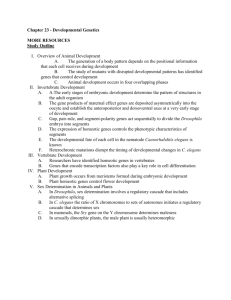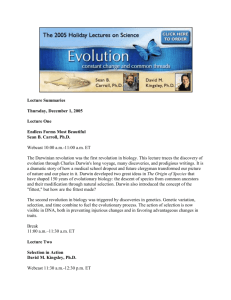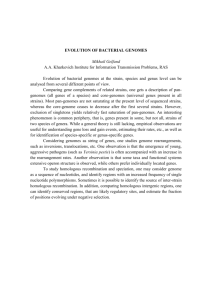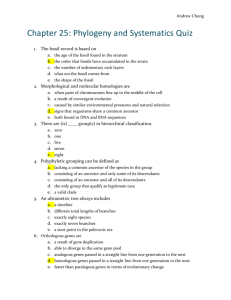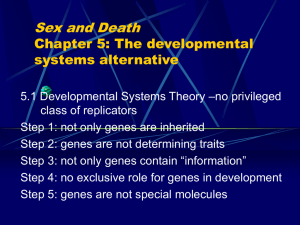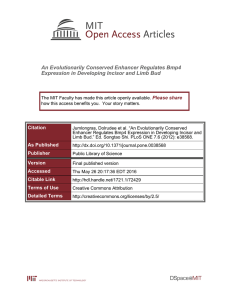Development and Evolutionary Change Chapter 21
advertisement
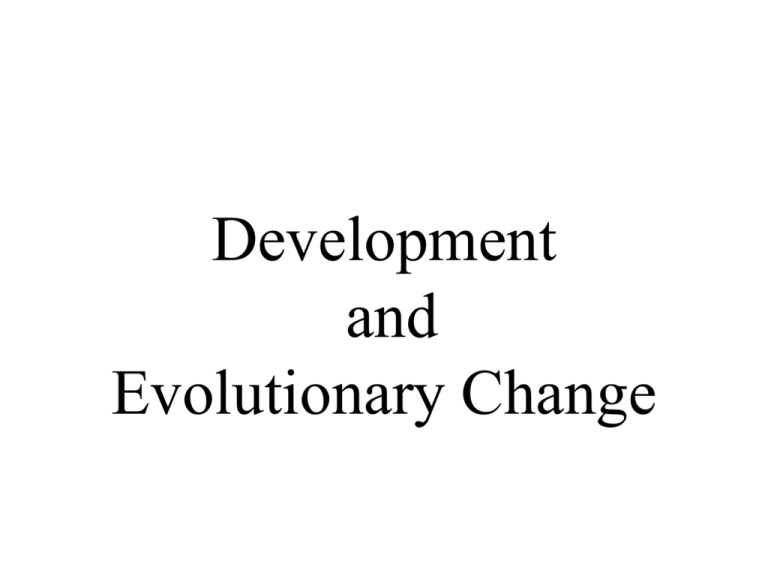
Development and Evolutionary Change mammalian limb bones are homologous Figure 1.2 bones are, wings aren’t Figure 25.2 leaf homologs Figure 25.3 Homologous larval stages Figure 21.1 Evolution and Development • evolutionary biology explains similarities among related organisms – homologous structures are inherited from a common ancestral structure – some homologies are visible in immature stages • due to homologous developmental processes – many shared developmental processes are guided by homologous genes fruit fly “leg-eye” formed by mouse Pax6 gene Figure 21.2 anterior/ posterior development Figure 21.3 Mutations in homeobox genes Figure 21.4 -Ubx -Hoxc-8 Evolution and Development • homeobox genes guide segmentation in insects and mammals – Drosophila ems, tll & otd and mammalian homologs guide anterior brain development – mutations in homeobox genes result in misassignment of segment identities many diverse developmental programs are initiated by a few common instructions but, once initiated, the programs produce vastly different structures Evolution and Development • differences in related organisms are due to developmental changes in the past – arthropods all use the Ubx gene in development • insect Ubx is mutated to prevent leg formation in the abdomen –insects have no abdominal legs –other arthropods have abdominal appendages arthropod use of Ubx Figure 21.5 foot making - chicks & ducks Figure 21.6 BMP4 Gremlin apoptosis webbing Evolution and Development • most birds develop without webbed feet – ducks retain their webs • BMP4 induces apoptosis in the cells of developing feet • Gremlin inhibits BMP4 to retain tissue around the digits of chicken feet • Gremlin inhibits BMP4 in duck web tissues as well • Gremlin inhibits BMP4 in chicken webs when applied experimentally Chicken foot webs Figure 21.7 Evolution and Development • heterochronic changes and modular development have reshaped salamander feet – when larval de-webbing of the feet is inhibited, adults retain “juvenile” feet • different modules develop independently • a change in one module’s development doesn’t alter development of another terrestrial arboreal Figure 21.8 Evolution and Development • Plants and animals are different – plant embryonic development does not involve cell migration – plant development is indeterminate; meristems constantly add to or replace modules – development is very plastic - responsive to environmental impacts Evolution and Development • plants and animals are different, but • plants and animals share some developmental genes – MADS box genes and homeobox genes • the shared developmental genes guide entirely different programs – animals are motile and develop accordingly – plants are sessile and develop accordingly Evolution and Development • development is the product of the complex interactions of gene products – expressed in response to informative signals • endogenous signals • exogenous signals that are predictive cooler soil temperatures precede the dry season warmer soil temperatures precede the dry season Bicyclus pupation Figure 21.9 Evolution and Development • exogenous signals affect development – seasonal temperature variations • pupation produces a dry-season or a wetseason adult Bicyclus butterfly –pupal soil temperature determines the adult form – seasonal day length variations trigger developmental changes in other animals and in plants Evolution and Development • exogenous signals affect development – different food sources • Nemoria moth caterpillars eat oak catkins in the spring & oak leaves in the summer –spring caterpillars resemble catkins –summer caterpillars resemble young twigs 1st year twig Figure 21.10 Evolution and Development • exogenous signals affect development – Daphnia developing in the presence of predatory fly larvae grow defensive “helmets” • Daphnia without helmets reproduce more efficiently Daphnia - with & without a helmet Figure 21.11 Evolution and Development • exogenous signals affect development – Spadefoot toads lay eggs in ephemeral pools – some years, nursery pools dry up before development is complete – tadpole development changes in response to increased crowding – mouth size and jaw muscle strength increase – bigger, tougher tadpoles cannibalize weaker siblings, increasing chances of maturing bean etiolation Figure 21.12 Evolution and Development • exogenous signals affect development – plant seedlings in low light exhibit lightseeking development (etiolation) • small, pale leaves; long spindly stems – when light is encountered, tissues return to normal photosynthetic development Evolution and Development • exogenous signals affect development – different modules respond differently • numbers of seeds produced varies in response to environmental conditions • seeds size tends to remain constant constant plastic Figure 21.13 Evolution and Development • exogenous signals affect development – not all signals cause responses • developmental responses are acquired through repeated exposure to informative signals –uninformative signals are “ignored” • developing organisms cannot respond to novel signals
